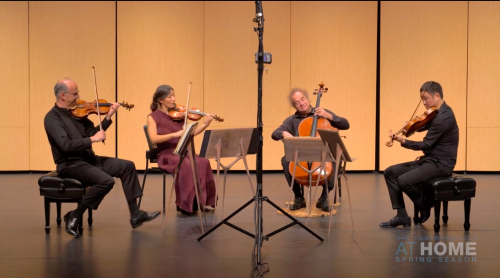 United States Haydn, Britten, Brahms: Takács Quartet (Edward Dusinberre, Harumi Rhodes [violins], Richard O’Neill [viola], András Fejér [cello]). Recorded at Lone Tree Arts Center in Denver, 15-16.1.2021, exclusively for Cal Performances at Home. Available on demand 25.2.2021 through 28.4.2021. (HS)
United States Haydn, Britten, Brahms: Takács Quartet (Edward Dusinberre, Harumi Rhodes [violins], Richard O’Neill [viola], András Fejér [cello]). Recorded at Lone Tree Arts Center in Denver, 15-16.1.2021, exclusively for Cal Performances at Home. Available on demand 25.2.2021 through 28.4.2021. (HS)

Haydn – String Quartet No.66 in G major Op.77 No.1 ‘Lobkowitz’
Britten – String Quartet No.3 in G major Op.94
Brahms – String Quartet No.3 in B-flat major Op.67
Classical music artists get through a pandemic in lots of different ways. Aside from having to perform mostly on video without a live audience in attendance, there is the issue of what to program. Try to soothe ruffled nerves? Lean into the angst with music that can express it? Give us something familiar as comfort food?
The Takács Quartet hedges its bets, in a way, for its annual (for the past 28 years) contribution to the Cal Performances season, recorded exclusively for the University of California presenter in January at Lone Tree Arts Center in Denver, not far from their home base at the University of Colorado in Boulder.
The program offers the final string quartets of three great composers. And they couldn’t be more different. Haydn’s uplifting String Quartet No.66 begins the proceedings, and Brahms’s easygoing, graceful String Quartet No.3 ends them. But the centerpiece, written by a composer nearing death, is Benjamin Britten’s String Quartet No.3, suffused with autumnal colors that try valiantly to overshadow insistent dissonances.
Britten completed the quartet in 1975 while living in Venice, and it premiered in 1976 only two weeks after the composer’s death. The finale even quotes from his 1973 opera, Death in Venice, which was set against a cholera epidemic.
As morbid as that might sound, the music is some of Britten’s most heartfelt and personal, even uplifting in the serenity of the final pages. Richard O’Neill, the Takács’s new violist, and second violin Harumi Rhodes set the tone with the quietly oscillating figure in the opening movement, ‘Duets’, gently nudging along the pace without haste. First violin Edward Dusinberre adds filigrees of higher-lying figures, and cellist András Fejér provides low-end support here and in other pairings as the music gets more agitated and then settles gently into the opening oscillation.
The second movement flips the arc, with a grim figure picking up hints of sweetness before settling back at the end. The third movement, ‘Solo’, features Dusinberre in a lament that ends in a deftly executed dawn chorus of birds among the four instruments.
After the short but pungent fourth movement, ‘Burlesque’, comes the finale, ‘Serenissima’, a passacaglia that’s based on a tightly constricted bass figure. The cello’s line barely extends past the interval of a fifth, yet Fejér manages to introduce a range of colors, until the music reaches a sense of quiet acceptance even as the final cadence leaves us hanging in midair.
It’s hard to imagine other music that can better reflect what many of us might be feeling after a year of barely relenting scary news.
Haydn’s last quartet seems to want us to forget such cares and just enjoy its sprightly nature. With body language and a palpable sense of brightness, the quartet grabs onto the high spirits of the opening march and executes the Adagio that follows with generosity. A lively Minuet leads to a high-spirited rondo Finale. The quartet lavishes rhythmic vitality and pinpoint accuracy on all this music.
To follow the Britten, Brahms’s relaxed, song-like writing in his final quartet gets a reading of elegance and finesse with plenty of nimbleness to carry the good-natured music along. It’s as if we hadn’t a care in the world.
Harvey Steiman
For the performance click here.
